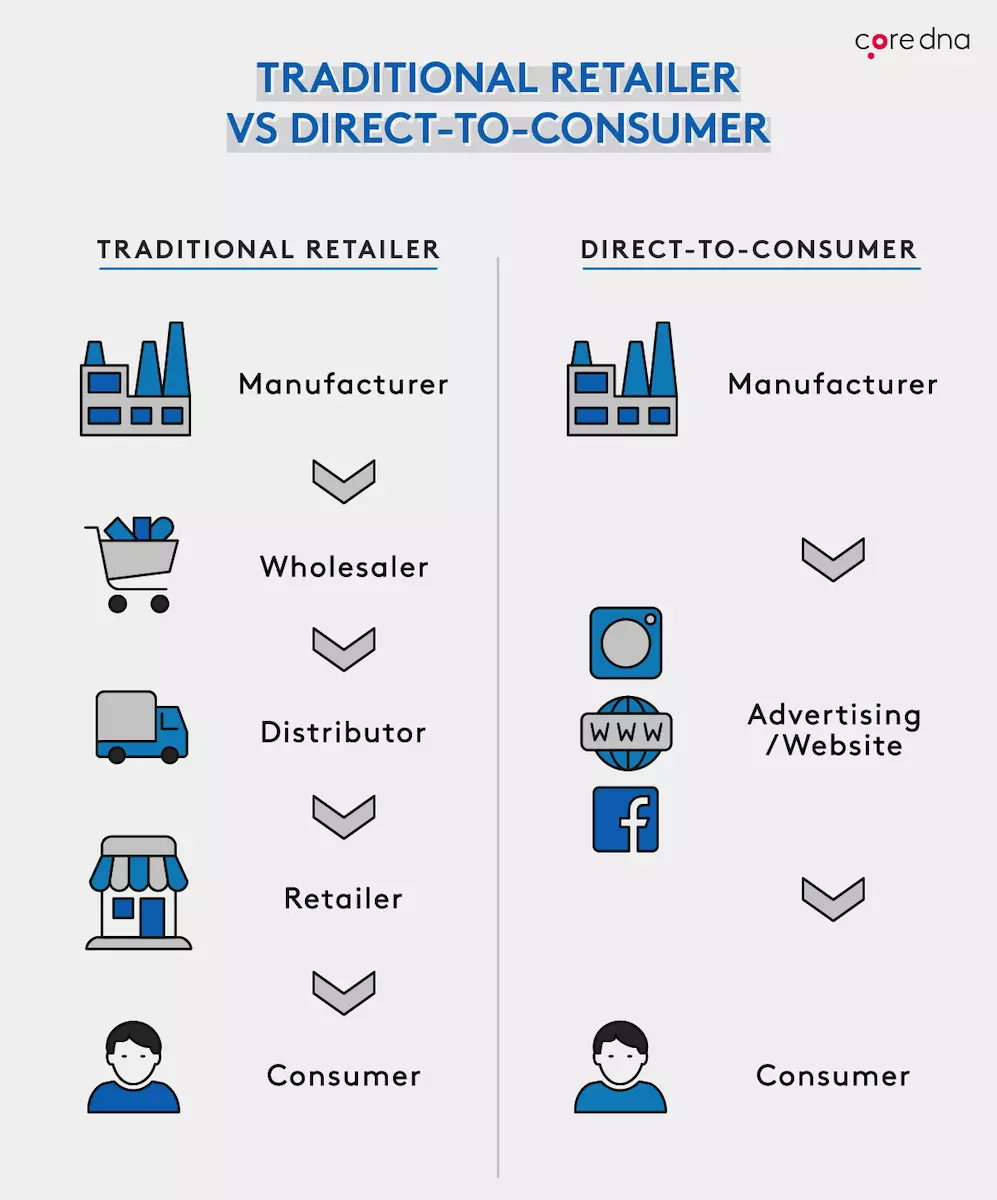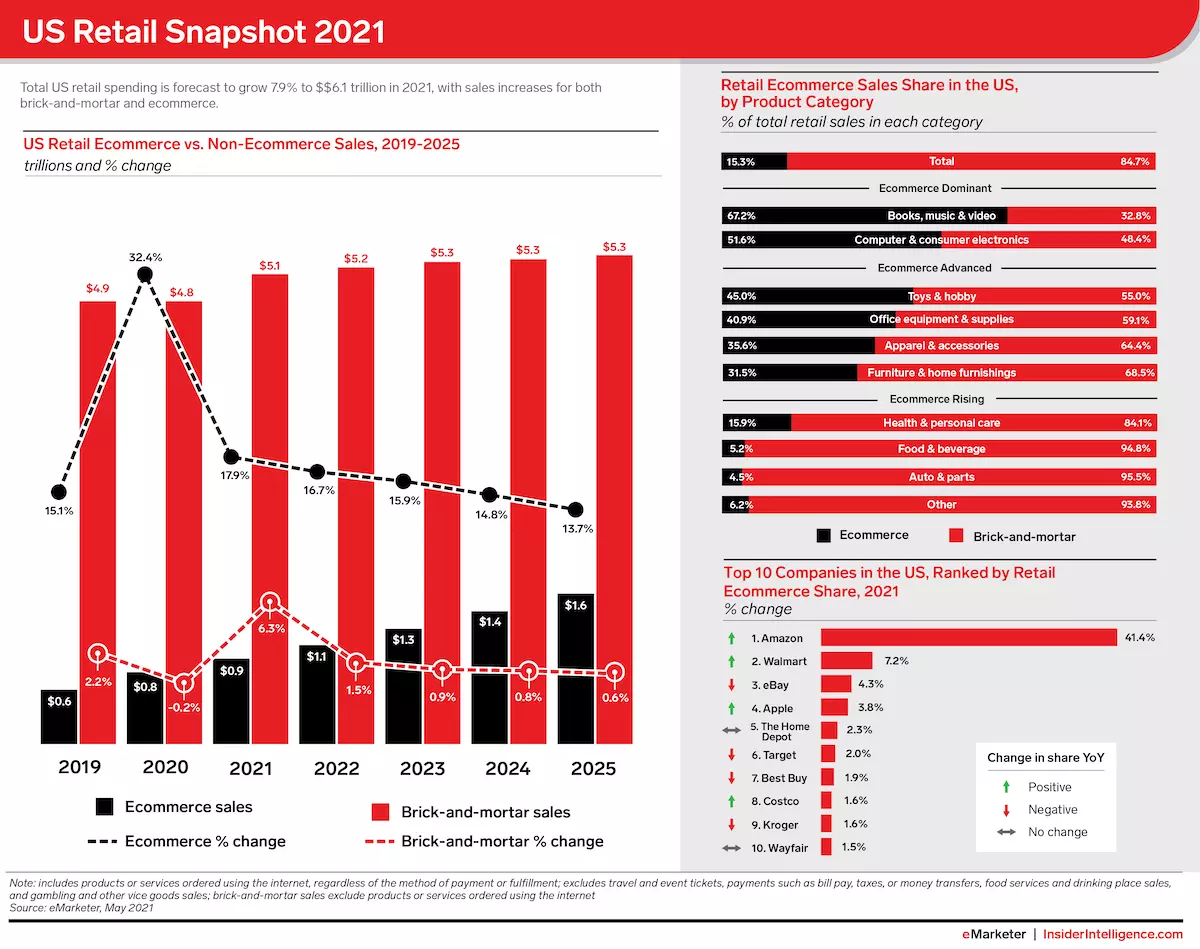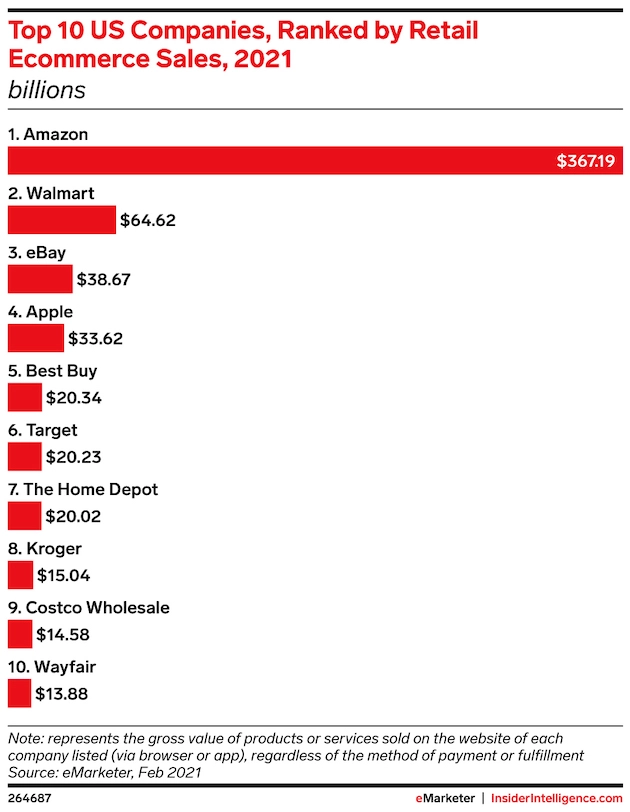Reading Time: 18 Minutes
Stores everywhere are considering whether it’s too late to shift their budgets to accommodate online shopping trends.
“[Summer 2020] has really pushed ecommerce adoption 10 years in the future. We’re actually at 2030 levels from where we believed ecommerce was going to grow.”
– Steve Hutt, Shopify
For distributors and direct-to-consumer brands alike, there is a massive push to develop a stronger digital presence. Physical stores have struggled in the face of COVID-19 and a tech-savvy consumer base. But the good news is that the demand for online shopping leaves plenty of room for new brands to join the digital space by switching from brick-and-mortar to ecommerce.
Ecommerce is a subcategory of retail that empowers shoppers to complete purchases online rather than having to visit stores in-person.
B2B and B2C brands are adopting ecommerce at a rapid rate since its inception in the 1990s. The last five years in particular demonstrate one of the largest supply-demand shifts in history.
Ecommerce also energizes several other closely-related retail trends, including:
The chief benefit of running an online store over a physical store is your ability to market and sell your products at a considerably lower cost. Brick-and-mortar stores require enormous overhead to maintain. By contrast, you can scale your brand far more easily and affordably online.

The digital capabilities of ecommerce software also make it easier for your customers to use different payment methods.
Online stores integrate remarkably well with countless marketing channels that allow you to reach laser-specific audience segments, personalize messages/products/services, and earn viral word-of-mouth marketing on social media.
Because you don’t need people “manning” your online storefront, ecommerce is open at all times for shoppers to view your items and complete a purchase.
Lastly, ecommerce platforms allow retailers to use data to better serve their customers. Visitor activity and buying trends can provide insights on about your ideal customers – their preferences, needs, and frustrations. You can then leverage these insights to build meaningful relationships with prospects and personalize your products.
As a direct-to-consumer brand, you enjoy additional benefits over other retailers. Traditional retail requires brands to employ several middleman agencies to maintain their business model.
DTC brands have far more control over their supply chain and sales channels. They don’t have to pay middleman agencies, and as a result, they can allocate those funds to connect with consumers directly.

DTC brands enjoy far more agility than do their traditional counterparts. That’s why it makes sense for most DTC brands to establish a strong ecommerce presence prior to or to strengthen their physical presence in storefronts.
Ecommerce was on the rise long before COVID, but the economic effects of a global pandemic have forced brands to rethink their approach.
The concept of “pandemic-proofing” one’s brand often means incorporating more digital services so that customers can buy without having to leave the safety and comfort of their homes.

Ecommerce sales continue to grow even after COVID restrictions loosened this Summer (2021). Online stores are remarkably convenient and even allow shoppers to price check from their phones while visiting physical stores in their neighborhoods.
Today, most large purchases take place in person. But the accelerated growth in retail belongs primarily to ecommerce brands.

And even in the case where large purchases occur more often in person, brands with a stronger ecommerce presence are more easily able to catch buyers earlier in their journey. High-ticket items make people want to research their options and perform due diligence online. That’s why many brick-and-mortar retailers who prioritize their online presence experience strong in-person sales performance.
“A record 9,500 stores went out of business in 2019, which seemed massive — but as many as 25,000 could shut down permanently in 2020, mostly in malls, says an estimate from Coresight Research. [As of August] 2020, more than 8,000 retail locations have gone dark for good, Coresight says.”
– Moneywise, 2021
High store closure rates continue into 2021, and the data consistently highlights brands that couldn’t survive without a robust ecommerce store. The combination of online shopping demands, lockdowns, and COVID-19 safety concerns prove too much for brands that insist on the traditional retail approach.
Few economists are surprised to see Amazon, Walmart, and Target on the top 10 list of ecommerce retailers in 2021. But what is surprising are the number of new physical retailers joining the roster.

Forbes noted that Insider Intelligence’s top 10 list (see above) doesn’t include formerly top-selling brands like Macy’s, and that the common denominator in all declining brands comes down to their weak online strategy. Meanwhile, new top 10 brands like Wayfair and Costco used the last few years to invest heavily in online sales and other ecommerce features like curbside pickup and social commerce.
Retailers not included on this list who also experienced notable growth since 2020 chalk up their success to an increased online presence and virtual personalization features. Nike is a prime example.
“CNBC interviewed John Donahoe, CEO of Nike, about the retail outlook for Fall 2021. Mr. Donahoe announced that Nike’s focus on customer experience allowed the brand to provide products, delivery, and innovation that are uniquely shopper-centric. This mindset also informed decision-makers to embrace digital connectivity at every opportunity.”
– GRIN, 6 Cyber Monday Black Friday buying trends to watch in 2021
For DTC brands, ecommerce success is far more achievable. That’s because those brands don’t have to negotiate terms with supply chain vendors before investing in their online presence. The DTC business model is uniquely agile and able to make changes at lower costs compared to their distributor or manufacturer counterparts.
The foundation to any online strategy is your website. What sets an ecommerce website apart from regular websites is that you need shopping and checkout functionality in addition to all other business website needs.
Your site needs a content management system (or CMS) that allows you to add and manage your product catalog. The website also requires:
Etailer marketplaces include online stores like Amazon and Google Shopping that allow you to set up additional digital storefronts online. These marketplaces often act as virtual shopping malls.
Not every DTC brand sells on Amazon, but many do. The best way to sell on Amazon is to become a Prime Seller.
Search engines like Google work hard to understand the content on each of your ecommerce pages so that they can refer your website to those looking for what you provide. For best results, you’ll want to add the right keywords into your product descriptions and ensure that search engines can easily crawl and index your web pages.
Most ecommerce brands hire SEO experts to help their website perform well on Google and other search engines.
Processing different types of payments usually incurs a higher cost. However, the more options you include, the easier it will be for shoppers to buy. Consider accepting major credit cards, as well as other payment methods such as:
Storing inventory and shipping orders is a critical part of ecommerce. Consumers demand shorter delivery times than they did a few years ago. The more streamlined your fulfillment process, the happier your customers will be.
DTC brands can leverage various remote features to provide expert sales or customer support. Live chat features allow you to connect with online shoppers 24/7, answer their questions about products, and troubleshoot order problems.
Being able to return and exchange products from your online store is a growing concern among shoppers today. Many customers are afraid to complete a purchase without assurances that they can return it if it wasn’t what they’d hoped for.
Though it may seem like a bad thing – making it easier to return unwanted items – the easier you make returns/exchanges, the happier your customers will be. It’s critical to remember that you aren’t just selling products: you are creating a customer experience.
Since an increasing amount of shopping happens on smartphones, the effort you put into making your website mobile-friendly will only enhance the customer experience.
Several leading social media platforms are launching features that make it easier for users to shop and buy from ecommerce brands. Facebook and Instagram lead the way with full in-app shopping capabilities.
These features are great for DTC brands because they are usually free, and they allow you to be in more places online at all times.
Shifting a brick-and-mortar to ecommerce is a form of digital transformation, meaning that much about your business model can change. But the learning curve required to take your brand online is a small price to pay for the low-cost, high-reward gains that ecommerce has to offer.
When you launch your ecommerce business, your marketing will shift online as well – content marketing, social media, pay-per-click (PPC), search engine optimization, etc.
Digital marketing is more robust than anything you get using traditional marketing tactics. For one thing, you’re no longer constrained geographically to the closest neighborhoods and cities. Also, it offers actionable data about who your customers are, what motivates them to buy, and how to engage them.
As such, you’ll need to become familiar with digital marketing platforms, such as certain social media channels, PPC advertising, and various types of content to drive website traffic and sales.
One of the best digital marketing techniques for DTC brands is partnering with social media creators. These influencers provide credibility and help you spread reliable word-of-mouth among members of your audience.
Instead of having products onsite, you will need to keep track of orders, update your inventory, and ship purchases in a timely manner. If you’re new to ecommerce, this will take some getting used to, but if you’ve selected the right ecommerce platform, you’ll quickly get the hang of the new workflow.
In many ways, sales and customer support becomes easier, because you can employ specialists in a virtual capacity. Many new ecommerce brands manage well on a remarkably small staff.
Depending on the size of your operation, you’ll need to consider whether email and live chat are enough to please your customers. Growing ecommerce brands might add customer service phone numbers, text message support, and chatbots to help them maintain relationships with customers.
Any major change to your business model takes time and effort to become profitable. But because ecommerce doesn’t rely on foot traffic and a pandemic-free world, it’s much easier to scale your brand online when making the switch from brick-and-mortar to ecommerce.
Online retail only enhances your store’s ability to personalize the shopping experience and serve broader audiences. For this reason, it is the perfect business model for DTC brands in the 21st Century.
Are you ready to stake your claim in the creator economy? Discover more helpful tips and resources from the experts at GRIN: Creator Management Learning Center
Our team keeps a finger on the pulse, so you’re always working with the latest information.